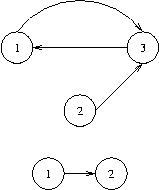http://poj.org/problem?id=2553
The Bottom of a Graph
| Time Limit: 3000MS | Memory Limit: 65536K | |
| Total Submissions: 8748 | Accepted: 3625 |
Description
We will use the following (standard) definitions from graph theory. Let V be a nonempty and finite set, its elements being called vertices (or nodes). Let E be a subset of the Cartesian product V×V, its elements being called edges.
Then G=(V,E) is called a directed graph.
Let n be a positive integer, and let p=(e1,...,en) be a sequence of length n of edges ei∈E such that ei=(vi,vi+1) for a sequence of vertices (v1,...,vn+1). Then p is called a path from vertex v1 to vertex vn+1 inG and we say that vn+1 is reachable from v1, writing (v1→vn+1).
Here are some new definitions. A node v in a graph G=(V,E) is called a sink, if for every node w in G that is reachable from v, v is also reachable from w. The bottom of a graph is the subset of all nodes that are sinks, i.e., bottom(G)={v∈V|∀w∈V:(v→w)⇒(w→v)}. You have to calculate the bottom of certain graphs.
Let n be a positive integer, and let p=(e1,...,en) be a sequence of length n of edges ei∈E such that ei=(vi,vi+1) for a sequence of vertices (v1,...,vn+1). Then p is called a path from vertex v1 to vertex vn+1 inG and we say that vn+1 is reachable from v1, writing (v1→vn+1).
Here are some new definitions. A node v in a graph G=(V,E) is called a sink, if for every node w in G that is reachable from v, v is also reachable from w. The bottom of a graph is the subset of all nodes that are sinks, i.e., bottom(G)={v∈V|∀w∈V:(v→w)⇒(w→v)}. You have to calculate the bottom of certain graphs.
Input
The input contains several test cases, each of which corresponds to a directed graph G. Each test case starts with an integer number v, denoting the number of vertices of G=(V,E), where the vertices will be identified by the integer
numbers in the set V={1,...,v}. You may assume that 1<=v<=5000. That is followed by a non-negative integer e and, thereafter, e pairs of vertex identifiers v1,w1,...,ve,we with
the meaning that (vi,wi)∈E. There are no edges other than specified by these pairs. The last test case is followed by a zero.
Output
For each test case output the bottom of the specified graph on a single line. To this end, print the numbers of all nodes that are sinks in sorted order separated by a single space character. If the bottom is empty, print an empty line.

Sample Input
3 3 1 3 2 3 3 1 2 1 1 2 0
Sample Output
1 3 2
求出连通块里的点满足下面条件:所有能到达点v的点w,v也能到达所有的w,因此要求的是联通块,然后缩点,求出度为零的连通块里的点,然后按照升序输出元素;
程序:
#include"stdio.h"
#include"string.h"
#include"queue"
#include"stack"
#include"iostream"
#define M 5009
#define inf 100000000
using namespace std;
struct node
{
int v;
node(int vv)
{
v=vv;
}
};
vector<node>edge[M];
stack<int>q;
int use[M],low[M],dfn[M],belong[M],num,index,in[M],out[M];
void tarjan(int u)
{
dfn[u]=low[u]=++index;
q.push(u);
use[u]=1;
for(int i=0;i<(int)edge[u].size();i++)
{
int v=edge[u][i].v;
if(!dfn[v])
{
tarjan(v);
low[u]=min(low[u],low[v]);
}
else if(use[v])
{
low[u]=min(low[u],dfn[v]);
}
}
if(dfn[u]==low[u])
{
num++;
int p;
do
{
p=q.top();
q.pop();
use[p]=0;
belong[p]=num;
}while(p!=u);
}
}
void slove(int n)
{
num=index=0;
memset(use,0,sizeof(use));
memset(dfn,0,sizeof(dfn));
for(int i=1;i<=n;i++)
if(!dfn[i])
tarjan(i);
}
int main()
{
int n,m,i;
while(scanf("%d",&n),n)
{
scanf("%d",&m);
for(i=1;i<=n;i++)
edge[i].clear();
for(i=1;i<=m;i++)
{
int u,v;
scanf("%d%d",&u,&v);
edge[u].push_back(node(v));
}
slove(n);
if(num==1)
{
for(i=1;i<=n;i++)
{
if(i==1)
printf("%d",i);
else
printf(" %d",i);
}
printf("
");
continue;
}
memset(in,0,sizeof(in));
memset(out,0,sizeof(out));
for(int u=1;u<=n;u++)
{
for(int j=0;j<(int)edge[u].size();j++)
{
int v=edge[u][j].v;
if(belong[u]!=belong[v])
{
out[belong[u]]++;
in[belong[v]]++;
}
}
}
int ff=0;
for(i=1;i<=n;i++)
{
if(!out[belong[i]])
{
if(ff==0)
printf("%d",i);
else
printf(" %d",i);
ff++;
}
}
printf("
");
}
}